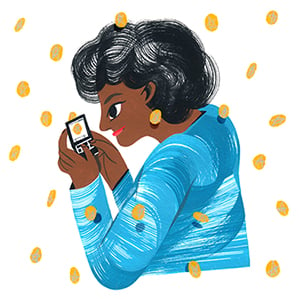Bitcoin-Inspired Digital Currency to Power Mobile Savings App
Proponents of the digital currency Bitcoin have often argued that money made out of computer code could help poor people access financial services. But so far applications for the technology have been almost exclusively aimed at people with Internet access and smartphones. Now a South African nonprofit is preparing to give the idea its first real test.

In the next few months, some teenage girls in poor areas of South Africa will be offered the chance to test out a kind of digital savings account operated via text messages. It will be offered as a new feature on a mobile social network service the girls already use. The savings feature will let people earn and save mobile airtime credit, which is used in addition to government-backed money as a currency in some countries.
Behind the scenes, the new service is powered by a digital currency called Stellar, which was inspired by Bitcoin. All savings balances and transfers will be represented using stellars, as the currency’s units are known.
Stellar, like Bitcoin, is based on a system that uses cryptographic software to create digital tokens that can’t be counterfeited. But Stellar differs from Bitcoin in that it is designed to act as an intermediary between conventional currencies and assets, to speed up transfers between them, and not as a means of payment in its own right. Development of Stellar is being undertaken by a nonprofit, the Stellar Development Foundation, backed by $3 million from the payments company Stripe (see “Increasing the GDP of the Internet”).
The Praekelt Foundation develops a piece of free software called Vumi that powers interactive services that can run over text messages on phones without data plans. Humanitarian organizations including UNICEF, USAID, and the Gates Foundation use Vumi to deliver health and education programs in Africa and elsewhere.
The new savings feature will be offered as an opt-in feature of existing social networking services built on Vumi and aimed at teenage girls living in poverty, says Gustav Praekelt, the head of the foundation. For most of the girls it will be their first opportunity to have a savings account, he says, something he hopes will lead to better decisions about money.
Tests of the savings service are planned for several countries. In addition to South Africa, Indonesia is likely to be a test market in the next few months, says Praekelt.
The savings feature works by rewarding teenagers with small amounts of airtime in return for sending messages, reading things, and doing other activities on the social service.
Because the software that powers Stellar is designed to make it easy for companies and organizations to quickly and securely transfer money back and forth, Praekelt says it eventually could become a framework for more sophisticated financial services. For example, governments or aid agencies could use Stellar to deliver payments to people, perhaps to reward participation in specific educational or health programs.
For now, the foundation is the only organization of any size publicly known to be making use of Stellar. Praekelt hopes that will change after companies and other nonprofits see the savings account service in action.
However, digital currencies have yet to see much take-up from conventional financial institutions or companies anywhere in the world. Kentaro Toyama, an associate professor at the University of Michigan who studies technology and development, says that even if Stellar does make it easier to build new financial services for poor people, it will still need to win the approval of regulators.
Most countries’ financial rules make it difficult for companies that are not banks to transfer and store money, often for good reason, says Toyama. That can be a problem for organizations trying something new, like offering savings or transfer services on mobile devices. The success of Kenya’s M-Pesa mobile payments system, a poster child for innovation in mobile money, illustrates the point. It was only made possible after the wireless carrier Safaricom got special approval from regulators, says Toyama.
Keep Reading
Most Popular
Large language models can do jaw-dropping things. But nobody knows exactly why.
And that's a problem. Figuring it out is one of the biggest scientific puzzles of our time and a crucial step towards controlling more powerful future models.
The problem with plug-in hybrids? Their drivers.
Plug-in hybrids are often sold as a transition to EVs, but new data from Europe shows we’re still underestimating the emissions they produce.
Google DeepMind’s new generative model makes Super Mario–like games from scratch
Genie learns how to control games by watching hours and hours of video. It could help train next-gen robots too.
How scientists traced a mysterious covid case back to six toilets
When wastewater surveillance turns into a hunt for a single infected individual, the ethics get tricky.
Stay connected
Get the latest updates from
MIT Technology Review
Discover special offers, top stories, upcoming events, and more.